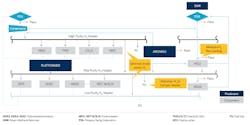If sustainability is going to have any chance of success, it’s crucial and unavoidable to adopt alternative energy sources such as hydrogen, solar and wind—and everyone knows it.
For instance, Compañía Española de Petróleos, S.A.U. (CEPSA) recently started coprocessing bio-feedstocks at its Energy Park CEPSA La Rábida refinery in Huelva, Spain. It also adopted five-year decarbonization plan in 2021, and is one of more than 50 worldwide oil companies that endorsed the World Bank’s Zero Routine Flaring by 2030 program. Operating since 1967, La Rábida was expanded in 2010 from 100,000 barrels per day (BPD) to 220,000 BPD.
The refinery operates a hydrogen network that’s integrated with an adjacent petrochemicals complex. The network has three hydrogen producers, including a platformer, aromax catalytic reformer and a steam reformer. The network’s main consumers are a hydrocracker and multiple hydrotreaters and petrochemical units that convert toluene to benzene and benzene to cyclohexane. Each consumer requires different hydrogen purity level (Figure 1).
To reduce its CO2 emissions and environmental impact, CEPSA recently optimized its hydrogen network to:
- Maximize utilization of hydrocarbon and petrochemical units, depending on economics;
- Minimize hydrogen losses to flare or fuel gas and reduce CO2 emissions from hydrogen production;
- Increase hydrogen feed to hydrocracker and other hydrogen-consuming units;
- Handle increased hydrogen required by bio-feedstock coprocessing; and
- Enable panel operators focus on more value-added activities.
Balance the hydrogen network
Because of the hydrogen network’s complexity, CEPSA undertook a two-phase project to balance it. It implemented Generic Dynamic Optimization Technology (GDOT) software from Aspen Technology Inc., which addresses the longstanding challenge of margin leakage in refineries and olefins plants by coordinating and optimizing multiple, closed-loop process units covering broad process envelopes.
The first phase was a steam methane reforming (SMR) application that was upgraded in 2011 to minimize flaring. It’s focused on the high-purity hydrogen section to reduce flaring by balancing the hydrogen header, and modulating the steam reformer (producer) with the hydrocracker and petrochemical units (consumers). Unit capacities were adjusted based on the hydrogen mix. With GDOT in place, average valve-open percent value in the hydrogen network decreased significantly, reducing hydrogen loss to flare by more than 70% or 250 Nm3 per hour, saving approximately 200,000 euros per year, and achieving a service factor of better than 97%. This equates to a reduction of approximately 1,400 tons of CO2 per year, which is 0.5% of the SMR’s CO2 emissions.
The second phase was performed in 2018, when GDOT was commissioned on the rest of the hydrogen network. Its goal was reducing hydrogen loss to fuel gas. This process also includes a pressure swing adsorption (PSA) section for hydrogen purification, which recovers hydrogen from the low purity header, and recycles it to the PSA section, instead of sending it to the fuel gas header. Again, after GDOT was deployed, hydrogen loss to fuel gas was reduced by 500 Nm3 per hour for a reduction of up to 80%, which saved about 250,000 euros per year. This equates to a reduction of approximately 2,800 tons of CO2 per year, if hydrogen production wasn’t limited.
In addition, GDOT accounted for each of La Rábida’s major hydrogen producers, consumers and recovery units that experience constantly evolving operational situations. GDOT also delivered value to CEPSA’s bio-feedstock coprocessing efforts by providing a clearer understanding about its hydrogen use and highlighting any restrictions. This helped CEPSA prioritize what it needed to maximize, such as hydrogen for bio-feedstock coprocessing feeds or other hydrogen consumer feeds, etc. Likewise, GDOT increased the cyclohexane unit feed by almost 10% or an equivalent of 1% increase in feed to the hydrocracker, when the system was limited by available hydrogen. In general, CEPSA reports that GDOT helps it quickly respond to volatile market conditions, such as elevated pricing for hydrogen and CO2 emissions credits.
Control simplifies complexity
“In short, sustainability has gone from simple to complex. It isn’t about simply moving from fossil fuels to solar and wind. The good news is better process control has a huge role in sustainability, and our advanced process control (APC) software can help users achieve their net-zero emissions and carbon pledges along with their efficiency goals,” says Ron Beck, senior solutions marketing director at AspenTech. “For example, we helped one of the global top five chemical companies save 9% on its energy consumption and costs over the last 10 years by using APC coupled with online engineering models, which inform their production units and process trains how to operate better. Plus, we recently added artificial intelligence (AI) functions for designing APC logic, which cuts the time and expertise needed, and lets users implement it faster.”
Because sustainability has diversified to include carbon capture, new types of electrification, green hydrogen, bioplastics and other new applications, Beck adds it’s more important than ever for each user to understand what their processes are doing, so they can decide what and how to change. “One big client told us they didn’t know how much CO2 they were producing, so that was the first question to answer. Everyone needs accurate information on what they’re emitting, such as which process units are the bad actors and how adjusting operations can improve their picture. And, if they can’t come up with their own answer, then they must reach out and collaborate. For example, plants in Europe are already required to report their CO2 emissions, so they’re seeking ways to track and calculate it, and respond in close to real-time. However, many of the solutions they need involve new use cases for existing software, with new business workflows, so we’ve been meeting with companies to help them determine what to prioritize.”






